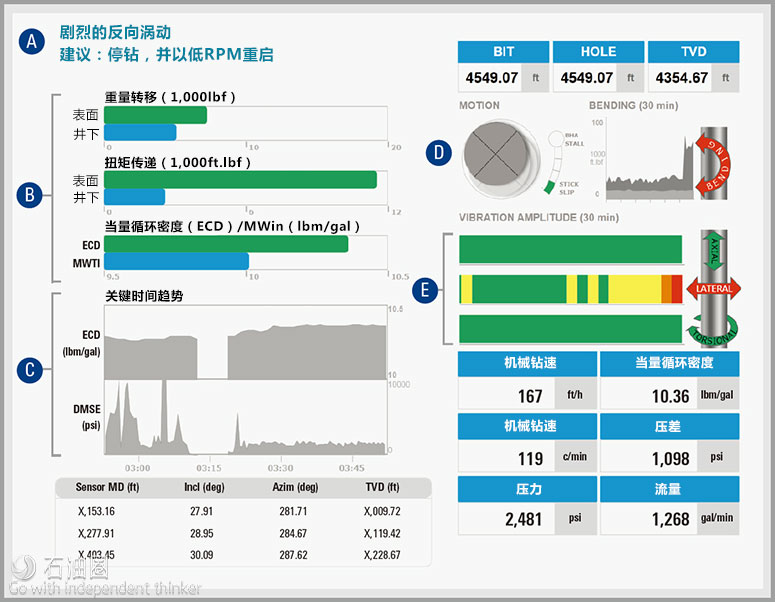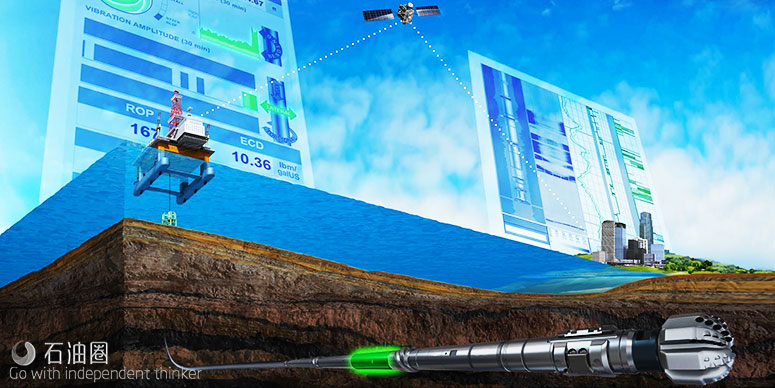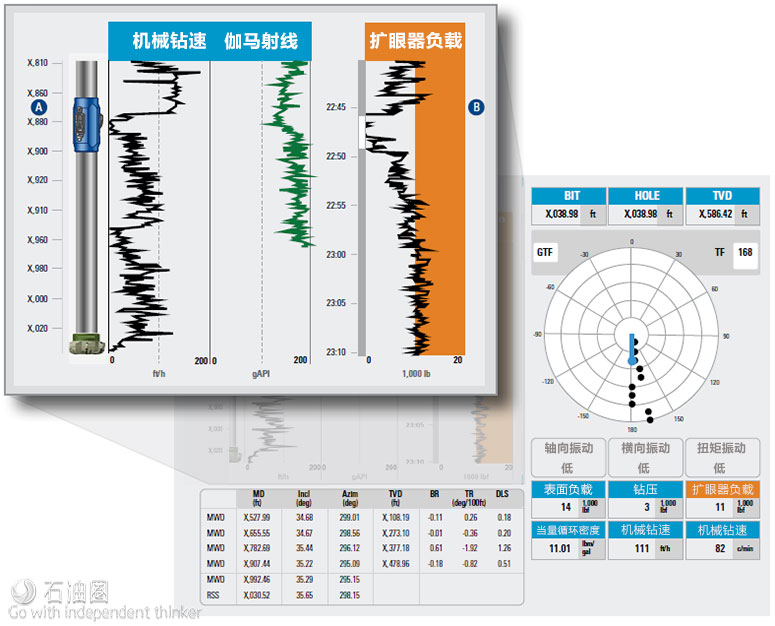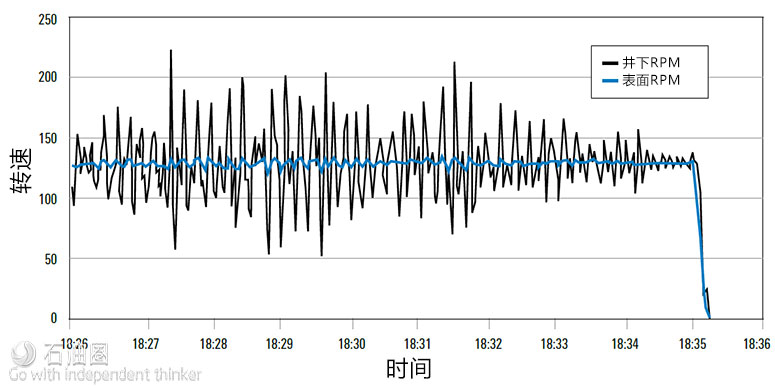OptiDrill Real-time drilling intelligence service
Manage downhole conditions and BHA dynamics with the OptiDrill* real-time drilling intelligence service. Integrated downhole and surface data provide actionable information on a rigsite display to mitigate risk and increase efficiency. These data are simultaneously interpreted by remote experts, who collaborate with the drilling team to improve performance.
Quantify risk and manage downhole conditions
The OptiDrill service helps you mitigate risk and improve drilling performance through early detection of ROP limiters and drilling hazards. Real-time motion detection and weight-on-reamer information allow the rigsite team to proactively manage parameters. The OptiDrill service provides the driller with immediate guidance on how to mitigate severe downhole dynamics. Early intervention typically lessens the severity of an event, protecting the BHA and extending the length of the bit run.
Mitigating shock and vibration to maximize drilling efficiency
The OptiDrill service detects whirl, bit bounce, and stick/slip motions and their severity. In the example below, a large-hole BHA is crossing a formation boundary and experiencing severe backward whirl. This motion is detected downhole by the OptiDrill service’s sub and displayed in real time with a recommended mitigation on the rigsite display.
Managing drilling parameters to extend the life of the reamer
In reaming-while-drilling applications, the OptiDrill service continuously estimates weight on reamer by combining downhole measurements from below the reamer with surface measurements. In the example below, the BHA is passing through formations with significant strength contrasts. The driller is using the estimated weight on reamer and a visualization of the reamer location to proactively manage surface weight to keep the weight on reamer within an acceptable range.
Receive while-drilling support from interpretation experts
Data from the OptiDrill service is transmitted to surface for use by the rigsite team and for interpretation by remote experts. The experts collaborate with the drilling team to reduce risk, improve drilling performance, and manage borehole quality.
Wellbore quality monitoring
To aid casing running, the service detects microdogleg and spiraling using bending moment data. Real-time wellbore quality data logs enable evaluation of the stability of the borehole over time.
Drilling performance improvement
In addition to the rigsite visualization of drilling efficiency information and immediate guidance for mitigating BHA dynamics, remote interpretations are shared with the rigsite team to help identify optimal surface parameters.
Risk mitigation
Automated quick event detection algorithms monitor for indications of plugged bit nozzles and drillstring washout. Using surface and downhole measurements, the OptiDrill service continuously calculates torque and drag to provide borehole friction factors for early identification of sticking pipe tendencies.
Improve future performance with postrun insight
The OptiDrill service records low- and high-frequency data, which are available for postrun analysis to evaluate drilling system performance. This information provides valuable input for the planning of future wells. Key applications of this recordedmode information include:
—validating and calibrating drilling models;
—increasing knowledge of formation drillability;
—optimizing BHA design and bit selection;
—evaluating the performance of drilling technology.
OptiDrill Service Eliminates 18-in Liner, Saves Statoil 10 Rig Days in Deepwater Exploration Well, Angola
Eliminate intermediate 18-in liner in deepwater well with shock and vibration expected
After drilling its first vertical exploration well in the presalt area of the Jacare field offshore Angola, Statoil aimed to eliminate the planned intermediate 18-in liner in the subsequent well. To accomplish this objective, Statoil would need to drill the 181/8-in section to the planned TD for the next section. This would require drilling through the salt in minimum time while opening the borehole to 21 in, and, ideally, in one run to avoid salt creep. If extended, this 181/8-in hole would be drilled from 2,555 m [8,382 ft] to 5,647 m [18,527 ft], passing through a layer of hard stringers at approximately 4,350 m [14,272 ft]—the original TD for the 181/8-in section.
Based on the first well drilled, Statoil anticipated shock and vibration in medium to hard salt formations that would negatively affect BHA performance. In the first well, this resulted in the need for a second bit run. Interbedded formations would likely make managing weight on reamer challenging and lead to premature cutting structure damage.
Use OptiDrill service to enhance BHA performance
Based on the length of the run and prejob modeling, Schlumberger recommended a multisegment solution with a primary focus on the use of the OptiDrill real-time drilling intelligence service. The OptiDrill service provides downhole drilling mechanics and dynamics measurement on a rigsite display for improved decision making. This information is also made available offsite for remote interpretation by the drilling team.
With increased knowledge of downhole conditions, Statoil could optimize drilling parameters to improve ROP, mitigate risk, and enhance cutting structure life. To improve management of vibration and to optimize bit and reamer weight distribution, Schlumberger recommended remote interpretation by a drilling analyst from Geoservices, a Schlumberger company. The BHA included the PowerDrive X6 RSS and Rhino system to maintain verticality and open the 181/8-in hole to 21 in.
Drilled 3,100 m of salt interval in one run, saving Statoil 10 days
Using the OptiDrill service and complementary technologies and services, Statoil accurately applied optimal drilling parameters. This led to enhanced BHA performance that enabled Statoil to drill through the Angolan salt at a record-breaking 30-m/h ROP and set a record for the longest salt run ever drilled in Angola. Furthermore, verticality was maintained throughout the interval, and the hole was underreamed without premature wear to cutting structures.
“We successfully drilled 3,100 m of a salt section in one run and avoided setting a potential intermediate liner in the salt, thereby saving around 10 days,” Statoil Drilling Engineer Marcel Emile Ngueguim said. “We recommend the use of the OptiDrill service where accurate information is needed to improve drilling performance and bit life, especially in deep water with hard or abrasive formations. It is also recommended in underreaming applications to accurately evaluate the weight distribution between the reamer and the bit.”


 石油圈
石油圈


